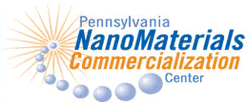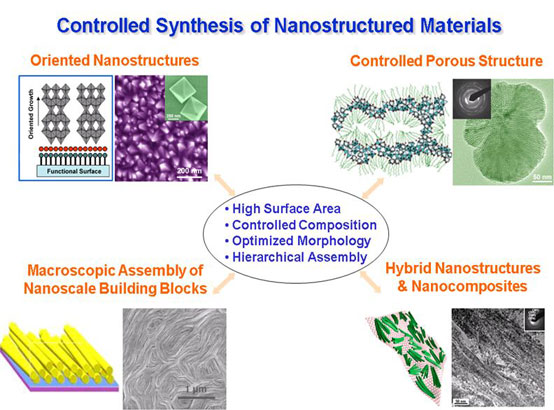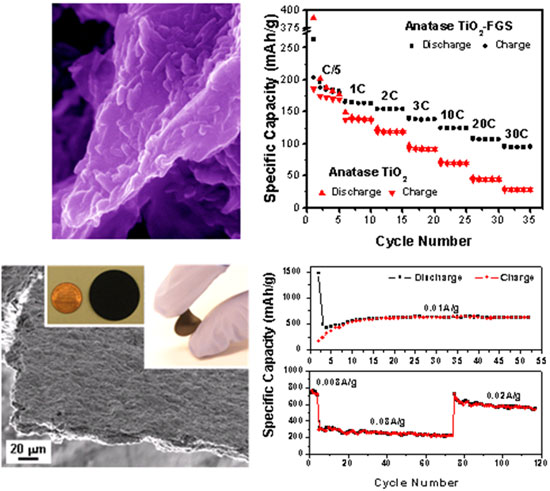|
Overview | Materials Synthesis | Energy Storage | Environmental Technology | Fuel Cells | Sponsors |
|
| Overview | |
|
Nanostructured materials often show unique physical and chemical properties. Our group is interested in a broad range of electrochemical, mechanical, and catalytic properties of nanostructured materials. We study the properties of a variety of nanostructured materials such as nanocrystalline and/or nanoporous inorganic materials, carbon nanostructures (carbon nanotubes and graphene), hybrid nanostructures, and nanocomposites. We also investigate fabrication methods for the assembly of nanostructured materials over multiple length scale for macroscopic device applications. We aim to use the knowledge of nanostructured materials to improve device performances in energy conversion and storage, and in bio/environmental technology. |
|
| Materials Synthesis | |
|
We use a variety of synthesis approaches to develop nanostructured materials with controlled composition, size, and morphology, and also assemble and fabricate these into hierarchical structures at the macroscopic level. These include the sol-gel, hydro/solvothermal, and high temperature synthesis methods, the controlled nucleation and growth and templating approaches, and self-assembly methods. |
|
|
|
|
| Energy Storage | |
|
Advanced electrical energy storage has been identified as a critical enabling technology for the development of fuel-efficient vehicles, improvement of electrical grid efficiency, and penetration of renewable energy into the electrical power supply. How well energy storage devices (e.g., batteries or supercapacitors) perform depends heavily on the properties of their electrode and electrolyte materials; emerging applications require revolutionary breakthroughs in electrode materials that will enable high voltage or multi-electron redox cathodes and high energy density, high capacity anodes, both with much improved charge transport and electrode kinetics, along with high structural and interfacial stability, all while being cost-effective. We have been working on development of novel electrode materials with controlled composition and nanostructures to enable high capacity, long cycling life, and high energy and power density, including olivine and spinel cathodes, intermetallic alloy anodes for Li-ion batteries, and nanocomposites for Li-sulfur and Li-air batteries. |
|
|
|
|
| Environmental Technology | |
| Active nanoparticles are efficient novel biocides due to their high-surface-area, abrasive characteristics and high surface reactivity, which leads to very close contact with cells and to subsequent biocidal effects. There is a need to develop multifunctional nanoparticle-based biocides that possess complementary desirable properties, to understand the basic composition-structure-property-performance relationships in these materials, and to further improve the efficacy of their destruction performance on bio-agents. We are developing multifunctional, reactive, composite nanoparticles targeted to improve the biocidal performance over conventional de-structuring agents. | |
| Fuel Cells | |
| Fuel cells have been recognized as an alternative power generation technique for the future in both automobile and stationary uses. One of the barriers to practical application of proton exchange membrane fuel cells is the high cost and poor stability of the catalyst. We attempt to solve this problem by designing and synthesizing novel catalysts with large surface area and long life by selecting appropriate compositions and designing hybrid nanostructures. | |
| Sponsors | |
|
|
 |
| Defense Threaten Reduction Agency | |
|
|
 |
| PA Nanomaterials Commercialization Center | |
 |
 |
| National Science Foundation |
Penn State Institutes of Energy and the Environment Penn State Materials Research Institute Penn State Battery and Energy Storage Technology (BEST) Center |
 Donghai Wang Group
An Energy Nanostructure
Laboratory
Donghai Wang Group
An Energy Nanostructure
Laboratory


